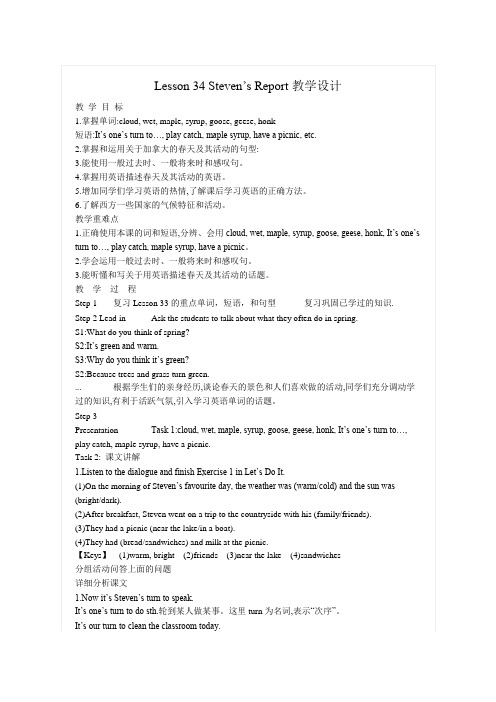冀教版七年级英语下册Lesson34 教案-新版
- 格式:docx
- 大小:22.05 KB
- 文档页数:4



Lesson 34 Steven’s Report教学设计【教学目标】1.Master the words and phrases:cloud, wet, maple, syrup--;It’s one’s turn to…, play catch--2.Ask students to master English sentence patterns describing spring and its activities.【教学重难点】重点:掌握本课重点单词、短语及句型。
难点:让学生掌握描述春天及其活动的英语句型。
【课时安排】1课时【授课时间】2020年( )月( )日星期( )【教学过程】一、导入环节(2分钟)(一)导入新课,板书课题导入语:Good morning, class. How are you? Today, we are going to learn:Lesson 34 Steven’s Report(二)出示学习目标过渡语:First ,let’s read the learning goals together.1.我要掌握单词和短语:cloud, wet, maple, syrup--;It’s one’s turn to…, play catch--2.通过学习,我要学会描述春天及其活动的英语句型。
过渡语:I believe everyone can achieve your goal? Can you ? Let’s begin .二、先学环节(15分钟)过渡语:First look at the guides carefully and then finish the tasks step by step.(一)出示自学指导1.读课文,划出不熟悉的单词、短语和句子2.完成自学检测(二)自学检测反馈Ⅰ.用所给词的适当形式填空1.Don't stand outside, or(否则) you'll get ________(wet) in the rain.2.There are many ducks and ________(goose) on my grandpa's farm.3.I had an egg, two ________(sandwich) and some milk for breakfast this morning.4.—What did you do just now? —I ________(feed) the cat.5.Look! There are some ________(cloud) in the sky. Let's take an umbrella.【Keys】1.wet 2.geese 3.sandwiches 4.fed 5.cloudsII.英汉互译1.it's one's turn to do sth____________ 2.play catch ____________3.make maple syrup__________4.have a picnic________5.give sb a big hand___________ 【Keys】1.轮到某人做某事2.玩传(接)球游戏3.制作枫糖浆4.野餐 5.给某人热烈鼓掌III.根据汉语完成句子1.现在轮到史蒂文发言了。

书院初中七年级英语学科教案Talk about your favorite day .•What season was it in?(季节)•How was the weather?(天气)•What happened ?(活动) 第三板块—当堂训练 Step6:Practice1. I had an egg, two _________ (sandwich) for breakfast this morning.2. —How many ________ (goose) are there on this farm? —About twenty.3. When did it begin _______ (snow) yesterday?4. —What did you do just now? —I ________ (feed) the cat.5. Look, there are some ________ (cloud) in the sky. Let’s take an umbrella.6.It's _____ ______ ______ clean the classroom.轮到我打扫教室了。
It's________ ____ ______ sweep the floor.轮到露西扫地了。
_______ _______ ____ watch the patient.轮流观察病人。
第四板块—课堂小结1. It's one's turn to do sth.轮到某人做某事 take turns in turns 依次;轮流2. go on a trip to...去……旅行3. have a picnic =take a picnic= go on a picnic4. feed sth.to sb./sth.=feed sb./sth. on sth.用某物喂某人/物 feed on 以……为食5. play catch 玩传球游戏6.feed sth.to sb./sth.=feed sb./sth. on sth feed on 以……为食 8.give sb a( big )hand作业布置1. Remember the new words and phrases in this lesson.(for all the students)2. Finish off Exercise4 in "Let ’s Do It!" (If you can)3.Write a short passage to introduce autumn in your hometown. (Challenge yourself)_____________'s Favourite DayWhat season was it in ? How was the weather?板书设 计Lesson34 Steven’s Report教后反 思weatherPlayed catchMade maple syrup Went on a trip Had a picnicFed the geese Ran to the carAfter breakfastAfter lunch。


Lesson 34 Steven’s Report教学目标通过本课的学习,学生能够:1.熟练掌握《英语课程标准》要求的“四会”词汇和句型: cloud、wet、havea picnic、play catch、“It’s one’s turn to…”等。
2.阅读文本,学会如何用英语介绍自己最喜欢的季节以及最喜欢的季节中一天的活动。
3.正确运用简单的一般过去时的句子描述过去的事情。
4.热爱生活,保护自然, 享受自己生活中的每一天。
语篇研读What:本课语篇是一篇记叙文,通过Steven介绍自己在最喜欢的季节经历的一次活动,讲述了春天的天气特点和难忘的活动经历。
Why: 作者通过Steven介绍自己在最喜欢的季节经历的一次活动,让学生能正确运用简单的一般过去时的句子描述过去的事情,培养学生热爱生活,保护自然, 享受自己生活中的每一天的生活态度。
How:语篇采用时间顺序讲述Steven的一天,先讲述上午天气晴朗,Steven和朋友们去野餐;再讲述下午天气骤变,大家淋雨的事情。
教学过程设计理念:以《英语课程标准》核心素养为导向,以单元主题为引领,基于语篇的育人理念,体现《英语课程标准》“学思用创”的英语学习活动观和“教—学—评”一体化设计理念。
续表通过练习巩固用法并进行知识迁移correct forms of the words in thebox.(Exercise 3)2. Show the PPT and finish theexercise.够完成习题,判断学生对重点短语和句型的掌握情况续表教学目标学习活动效果评价设计意图通过小组合作,寓教于乐,学生在轻松的学习过程中掌握知识,提高能力,达到迁移创新的目的【迁移创新】Activity 7: Group work通过小组讨论,灵活运用本课知识,完成小语篇写作1. Retell the story.2. Interview a friend or a familymember about their favourite day.Write a short passage.1. What season was it?2. How was the weather?3. What happened on that day?观察学生小组采访,倾听学生的采访并根据实际情况给出必要的指导和反馈设计意图以采访形式展开调查,最终形成书面的语言输出,提高学生写作能力【迁移创新】板书设计Lesson 34 Steven’s ReportSteven’s Favourite DayTime Weather ActivitiesAfter breakfastAfter lunch作业设计基础型作业:Review and recite the important points of this lesson.实践型作业:Interview a friend or family member about their favourite day.Write a short passage.教学反思。
Lesson34教案
Teaching goals
1. Target language目标语言
a. Learn and master the following words and phrases:掌握词汇及短语maple syrup goose honk cloud wet
go on a triphave a picnicfeed the geesebecome darkgive sb. a big handb.句型
1) Now, it’s Steven’s turn to speak.
2) Let’s give him a big hand, class.
3) Today is another good day.
2. Ability goals能力目标
Learn how to tell an activity
Aim of emotion
Practise speaking more and don’t be scared if you are a beginner Teaching Important and Difficult Points:教学重难点
Learn how to tell an activity
Teaching methods教学方法
Listening and speaking.
Teaching aids教具准备
Audiotape.
Teaching procedures & ways教学步骤与方式
Step I Greeting and lead-in
Greet the students and get them to review what they learned from the former text.T: Who can say something about spring, such as weather, activities?
S:…..
T: Do you like spring?
S:…..
Lead in the new text.
Step II Learn the text
1. Listen to the tape and do the exercise 1from “Let’sDo It”
T: Listen to the tape carefully and circle the correct words.
Read the text and finish the exercise 2from “Let’sDo It”
2. Grasp important sentences of the text.
1) Now, it’s Steven’s turn to speak.
It is one’s turn to do sth.该某人做某事了
例句:It is your turn to clean the room轮到你打扫房间了。
2) Let’s give him a big hand, class.
give a hand帮一下忙,give sb. a big hand向某人鼓掌。
例句:I'm willing to give a hand at preparing the meal.我愿帮忙做饭。
Let's give the young singer a great/big hand.让我们鼓掌欢迎青年歌手。
3)The class claps loudly。
The class全班集体名词
若当整体看,则谓语动词用单数形式。
例句:Our class is very diligent.若他们表示的人或者事物当作若干个个体来看,谓语动词则用复数形式
例句:When I came into the room, his family were watching TV.
loudlyloudaloud区别:
aloud, loud二者作为副词,都有“大声地”、“响亮”的意思,有时可以通用。
但aloud与read,think连用时,表示“出声”,而loud用于talk,speak,shout,laugh等动词之后,在口语中代替loudly
①aloud强调发出的声音能被听见,意思为“出声地”或“大声地”,常用read,call等动词连用。
例如:Please read the text aloud.请朗读一下课文。
②loud意为“响亮地”、“大声”或“高声地”,侧重发出的音量大,传得远,一般多用来修饰speak,talk,laugh等动词。
loud还可用作形容词。
例如:Speak louder, please, or no one will hear you.请大声些,否则没人能听见。
③loudly意为“响亮地”,其基本意义与loud相同,还常与ring,knock等动词连用。
loudly放在动词前后均可,含有“喧闹”或“嘈杂”的意味。
例如:Suddenly the bell on the wall rang loudly.突然,墙上的铃大声地响起来。
aloud, loudly只能用作副词;loud既可作副词,也可用作形容词。
当副词用时,loudly与loud一样用来说明声音的强度,意思是"高声地,喧噪地",只是在动词后面loud比loudly更常用些。
他们的反义是:quietly。
例如:Don't talk so loud (loudly)—you'll wake the whole street.别那么大声说话,你快把左邻右舍都吵醒了。
Someone knocked loudly (loud) at the door.有人在大声敲门。
注:而aloud往往与动词read和think连用,表示真的把话说出,而不是在脑子里默默地"说"。
She has a very good pronunciation when she reads aloud.她朗读时,发音很好。
4) Today is another good day.
another
形容词①又一,再一例句:He drank another glass of beer.他又喝了一杯啤酒。
②另一;另外的例句:That's another matter.那是另外一回事。
代词pron.①又一个,再一个
例句:The little boy finished his cake and asked for another.小男孩吃完自己的饼后,要求再吃一块。
②另一个
例句:I don't like this one, please show me another.我不喜欢这个,请给我另一个。
Finish the exercise 3from “Let’sDo It”
Step III
Divide students into several groups and finish the task of Exercise 4from “Let’sDo It”Step VI
Homework
a. Finish the exercises in Activity book.
b. Preview 35.。